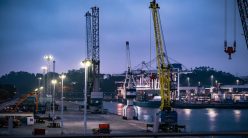Marchio Irfan Gorbiano
The Jakarta Post
The government believes the manufacturing sector will be the new engine of economic growth for Indonesia and will, therefore, focus on its development in the next five years.
National Development Planning Agency (Bappenas) head Bambang Brodjonegoro said developing the manufacturing sector was vital to increasing Indonesia’s potential GDP growth and, at least, maintain the growth in the long run.
image from https://pixabay.com/en/rolls-of-fabric-factory-material-1767504/ (free download)
“We need to somehow refocus on the manufacturing sector. Manufacturing is a prerequisite for boosting economic growth,” Bambang said in Jakarta recently.
A joint report by the Asian Development Bank (ADB) and the Bappenas estimates that Indonesia will see an average growth rate of 6.31 percent between 2020 and 2024 under the “good scenario”. This scenario projects the share of employment in the manufacturing sector to increase gradually during the period to 20 percent of the workforce by 2024.
Under the “bad scenario”, which assumes the share of employment in the manufacturing sector will slightly decrease to 13 percent, the report estimates Indonesia’s potential GDP growth rate to hit 5.52 percent on average between 2020 and 2024.
Indonesia’s manufacturing sector employs 14.72 percent of the workforce, according to Statistics Indonesia (BPS) data from August 2018, while the agriculture sector remains the country’s primary employer by using 28.79 percent of the labor force.
Developing the manufacturing sector is also essential to reducing the country’s dependence on raw commodity-based exports with relatively low complexity and linkages to other industries.
The country’s dependence on commodities is susceptible to price swings in the market and therefore provides the Indonesian economy with a weaker platform compared to downstream products of the manufacturing-based exports, Bambang argued.
The minister said the next medium-term development plan (RPJMN), which was being drafted by Bappenas, would stress on value-added creation in the economy, particularly in the manufacturing sector, so that the country could diversify its export products.
“By creating the value-added we can participate more in the global value chain. Our product complexity will improve because of higher added value,” said Bambang. “That’s the idea of our manufacturing strategy.”
The first step in developing the manufacturing sector be to boost the complexity of exporting Indonesia’s natural resource, which means developing more downstream products considering its abundance in the country as well as its major presence in the country’s trade data, Bambang said.
Data compiled from Bappenas revealed that more than 30 percent of Indonesia’s exports in 2018 was from commodity-based sectors such as coal, vegetable oil and fats, natural gas, as well as petroleum and its derivative products.
ADB’s advisor in economic research and regional cooperation department, Jesus Felipe, said collaboration between the government and private enterprises in the manufacturing sector was essential to identify problems hampering the sectors’ development as well as new exports products.
“The government needs to initiate dialogue with the private sector to jointly identify and address obstacles to the development of a modern manufacturing sector. It is critical for policymakers and the private sector to collaborate in discovering those new and more sophisticated products that Indonesia could successfully diversify into,” he said.
ADB’s director general of Southeast Asia department, Ramesh Subramaniam, concurred, saying the public and private sectors’ collaboration was vital in determining the direction of upskilling workers to better fit industry demands along with the development of the manufacturing sector.
Bank Mandiri chief economist Anton Gunawan said the government needed to have comprehensive policies geared toward specific subsectors of the manufacturing industry in order to more effectively develop the industry.
“We cannot really serve everyone’s interests, but we have to choose the kind of policies [that need to be directed],” said Anton.
He also emphasized the need for the government to ensure a favorable business climate in order to attract new investments in the manufacturing sector.
The original article posted in https://www.thejakartapost.com/news/2019/02/11/manufacturing-sector-to-drive-indonesias-economy-bappenas.html





